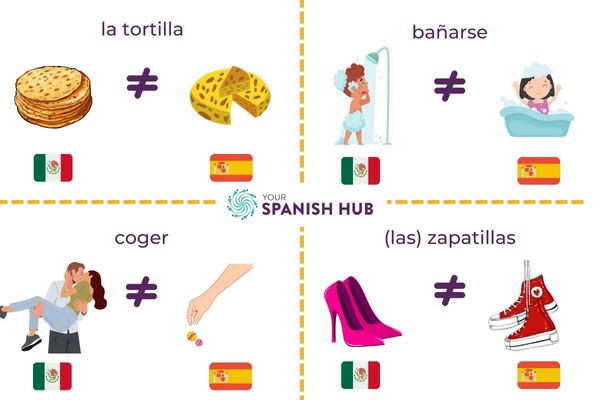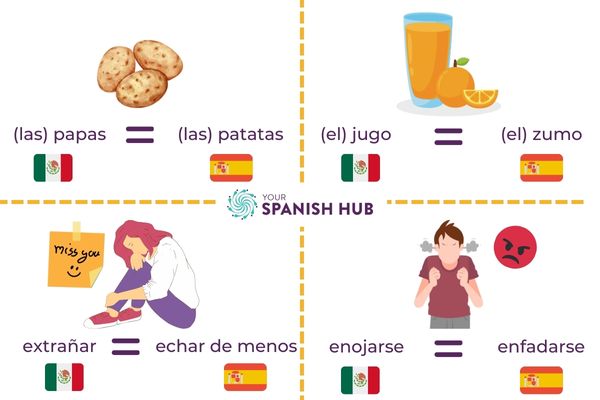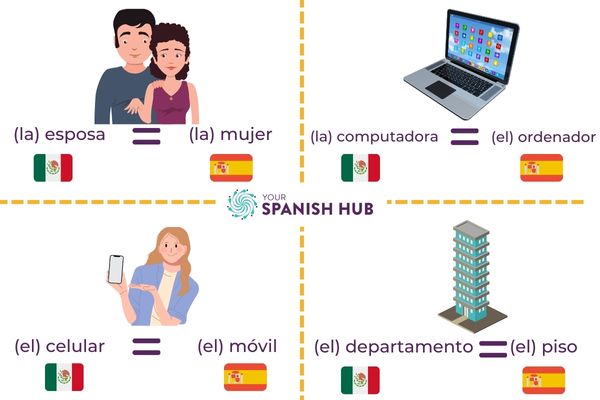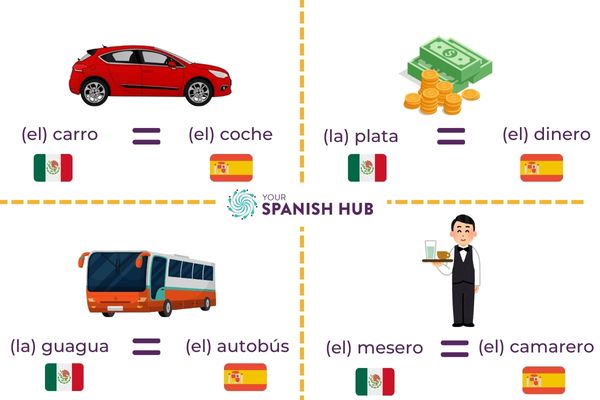If you think of Spanish Spanish vs Mexican Spanish you will find that they have many differences, which add richness and variety to the language and are a faithful reflection of the people and the different regions where it is spoken.
According to the latest annual report of the Cervantes Institute, Spanish is the official language in 21 countries, it has about 493 million native speakers (this is 7.5% of the world population) and more than 24 million students learn Spanish.
Spanish is the third most used language on the internet, after English and Mandarin Chinese, and the second most used language on digital platforms: YouTube, Facebook, Netflix, Linkedin, Wikipedia, Instagram, etc. Almost 8% of all internet users communicate in Spanish!
With these figures, it is not surprising that there are notable differences between a native speaker from Cuba and one from Argentina, to give two examples.
In this article we are going to explore some notable and interesting differences between the Spanish Spanish vs. the Mexican Spanish, which in my opinion, give flavour and richness to the language.
There are students who, for work, family reasons, or simply personal preferences, choose a native teacher from a specific Spanish-speaking country for their Spanish language classes.
For example, it is typical for students from California to look for teachers from Mexico and students from the United Kingdom to be more inclined to look for teachers from Spain, because as we will see in the article, the differences between Spanish Spanish vs Mexican Spanish can be notable.
But even on a smaller scale, for example, if we look at Spain, if your Spanish language classes are with a teacher from Salamanca, with a teacher from Seville or with a teacher from Tenerife, the accent and some vocabulary words will be different.
The language is the same and you will be able to speak with natives from all over the world, don’t worry, but there are nuances and differences that you must know.
In Spain, we have two styles when we speak: the formal and the informal style.
We use the formal style to address our bosses, older people, or people we do not know to whom we want to show respect.
On the contrary, we use the informal style with our family, friends and relatives.
For me (I live in Cuenca, in the centre of Spain) I only use the formal style 10 or 15% of the time.
However, in Mexico (in Latin America and in the Canary Islands), they generally use the formal style by default.
What is the difference from a grammar point of view?
It involves the use of the subject’s pronouns:
The conjugation of verbs is different, as well as other types of personal pronouns (reflexive, direct and indirect object…).
Let’s look at some examples.
FORMAL STYLE:
INFORMAL STYLE:

This happens in many languages: the same word has two different meanings, depending on where you use it.
For example, I remember when I lived in Virginia (USA) in 2016 and 2017 and later, I lived in Wales (United Kingdom) in 2018 and 2019, there was one word in particular that always confused me: football.
In Spain, the king of sports is ‘fútbol’ (Real Madrid, Fútbol Club Barcelona…) and, as a good fan, I usually enjoyed on TV my favourite team’s games (Hala Madrid!!) when I lived abroad. When I watched the games on television and I talked about it with my friends… It was always super confusing talking about this sport: soccer, football?In your Spanish language classes, your teacher probably emphasises these words. My friends from Virginia still think I’m a huge Tom Brady fan 🤪
Let’s look at similar cases between Spanish Spanish vs. Mexican Spanish.
A ‘tortilla’ in Mexico is a type of flatbread made with corn dough that is part of the daily diet. A ‘tortilla’ in Spain is one of our most traditional dishes, made with eggs, potatoes and onion (optional).
‘Bañarse’ in Mexico means taking a shower, that is, standing while we wash our body, more or less in 5 or 10 minutes. While ‘bañarse’, in Spain means taking a bath, filling the bathtub with water and getting inside to enjoy a relaxing bath for at least 20 or 25 minutes.
‘Coger’ in Mexico means to have sexual relations with another person. While in Spain it means holding something with your hand or picking up/taking the bus, the train…
‘Zapatillas’ in Mexico refer to footwear with a heel, it is not something that we think is comfortable. While in Spain, ‘zapatillas’ means sneakers, flat and comfortable footwear.

We finish this article on the differences between Spanish Spanish vs Mexican Spanish with the case in which two different words have the same meaning.
I see this case a lot in my Spanish language classes with students who use Duolingo as a complement to their Spanish classes, for example with “carro” and “coche” and with “mesero” and “camarero”.
This is not a mistake, just keep in mind that if you are in Spain, they will not understand you well if in a bar you say: ‘Mesero, por favor, ¿me puede traer la cuenta?’😉
Both words refer to the carbohydrate-rich tuber (potatoes).
México: Voy a comer carne con papas.
España: Voy a comer carne con patatas.
Both words refer to the liquid we obtain when squeezing the fruit (juice).
México: Me gusta tomar un jugo de naranja natural por la mañana.
España: Me gusta tomar un zumo de naranja natural por la mañana.
Both words refer to the feeling of longing or sorrow for the lack of something or someone (to miss something or someone).
México: Ahora que vivo en Japón, extraño la comida de mi país.
España: Ahora que vivo en Japón, echo de menos la comida de mi país.
Both words refer to the unpleasant feeling that something or someone we don’t like causes us (to get angry).
México: Marta se enojó con David porque llegó muy tarde a su cita.
España: Marta se enfadó con David porque llegó muy tarde a su cita.

Both words refer to the woman someone marries (wife).
México: Mi esposa trabaja en el hospital, es enfermera.
España: Mi mujer trabaja en el hospital, es enfermera.
Both words refer to the electronic device that we use nowadays to work, send emails, watch series, have online Spanish classes… (computer).
México: Necesito una computadora nueva.
España: Necesito un ordenador nuevo.
Both words refer to the electronic device that we use nowadays to talk, send messages, photographs, videos, emails, view and participate in social media… (cellphone)
México: Me he quedado sin batería en el celular.
España: Me he quedado sin batería en el móvil.
Both words refer to a home with several rooms that is in a collective building with more similar homes (flat).
México: Vivo en un departamento en el centro de la ciudad.
España: Vivo en un piso en el centro de la ciudad.

Both words refer to the vehicle intended for the transportation of people, generally with capacity for five people (car).
México: Mi vecino tiene tres carros.
España: Mi vecino tiene tres coches.
Both words refer to money money 🤑 that we use to buy things.
México: Un piloto de Fórmula 1 gana mucha plata.
España: Un piloto de Fórmula 1 gana mucho dinero.
Both words refer to a collective transport vehicle (bus).
México: María y Fernando van a alquilar una guagua para llevar a los invitados de la boda de la iglesia al restaurante.
España: María y Fernando van a alquilar un autobús para llevar a los invitados de la boda de la iglesia al restaurante.
Both words refer to the hospitality worker who serves food and drinks and charges for drinks in bars and restaurants (waiter).
México: Le pedimos al mesero que nos trajera otra botella de vino tinto.
España: Le pedimos al camarero que nos trajera otra botella de vino tinto.
One of the big differences between Spanish Spanish vs Mexican Spanish that we have not seen yet in this article has to do with the pronunciation of these syllables:
That in Mexico and more places in Latin America and Spain are pronounced the same as the syllables:
It is the phenomenon known as ‘seseo’ and that you can hear if you watch television series or movies.
Another interesting phenomenon in Spanish is ‘voseo’, which consists of using the pronoun ‘vos’ instead of ‘tú’. It is very common in Argentina, Uruguay and Paraguay.
These differences between the Spanish language of the different countries in which it is spoken do not constitute an obstacle or a problem, quite the opposite, they are another element of the richness and variety of the language.
If you learn Spanish with a teacher from Mexico, everyone will understand you if you come to Spain, and vice versa.
The same thing happens in all languages, and the richness and variety of accents, vocabulary and grammar (sometimes giving rise to dialects) is greater the greater the geographical range in which the language is spoken.
In my case, I learned English in Virginia (USA) and then, I spent a year in Alberta (Canada) doing my master’s degree. From there, I went to Wales (UK) to work for a year and one of my best friends is from Singapore.
With my English, I can communicate and keep my professional and personal relationships with people from Scotland, Australia or India. It is true that I need a few minutes to get used to the different accents, but that is part of the beauty of opening up to the world and to people from different countries, cultures and traditions. If you want to continue learning more about the Spanish language, its nuances and its culture, in a well-structured way, with the guidance of an accredited native teacher, I invite you to visit our catalogue of Spanish classes. Book your trial class with us today and meet your teacher (in this case, from Spain 🇪🇸😉).
